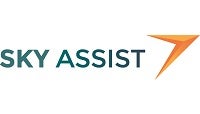
Many efforts have been made the last decade to enhance passenger experience through self-service offers, but mainly in pre-departure area only like online check-in, self-baggage tagging or self-baggage drop. However passengers claim interest for more initiatives in that sensible part of the journey too, seen as the second factor in having an (un)pleasant journey.
Furthermore, specific situations like strike, storm, snow, or full baggage container not loaded, can quickly lead to stressful situation for the agents facing increased frustration of passengers by having to queue for hours in chaotic environment.
Hopefully, alternatives now exist to ease the declaration process and have the passengers leaving the airport quickly, that is also crucial for airport security.
Using simplified and user-friendly self-comprehensive interfaces, the passenger can in less than 5 minutes declare delayed baggage using an airport kiosk (good alternative to queues in normal operation but less in major incident) or an online application using a security token and duplicate / fraudulous file prevention principles.
During the May strike in Brussels, Brussels Airlines passengers informed their passengers to use the online application providing the necessarily information at the airport and through social media. 72% of the passengers entered their declaration using the web interface, which also accelerated the overall process as after having left the airport with declaration it is always difficult, if not impossible, to get an agent on the line.
In less than 4 days, over 5730 files were e-declared by Brussels Airlines passengers, and Air France had even a more intensive usage during last winter with more than 11.000 files declared by passengers in 1 day after the airport closure because of exceptionally freezing situation.
Qantas auto-mishandled industry project went a step further for their frequent travelers, by offering them a permanent bag tag. Using multiple interfaces (FFP, DCS Altea and WorldTracer), when a baggage is identified as delayed the system automatically creates the delayed baggage report and informs the passenger on his mobile while he is still flying, preventing him to wait wastefully in front of baggage belt. In Brisbane for example, more than 80% of the baggage are treated in such way.
But it does not stop at declaration. After the declaration, the passenger is most of the time blind and desperately tries to enter in contact with an agent to get information about his luggage recovery, without success. This adds frustration but also gives extra workload for the agents, as they have to try to get in contact with the passengers to get updated information as the incident evolves like for example new delivery address information or a description of the content of the baggage. Online access to all that information is now available, together with communication control given to the passenger.
How does this work? First the passenger connects to the URL from the airline or handler website, opening the online follow-up application using his file reference and name or the link received per email. The passenger can then not only verify a full history of his incident, but also update his contact or address information if necessary after a hotel change for example, enter his baggage content list after having received per email the necessity to do it in order to facilitate the recovery process after 2 days or get the necessary contact to an agent.
Pro-active notifications can be sent by the system per email or SMS each time there is a change in the baggage incident: a rush message, a reception at the local airport, a need for updating his details or a delivery preparation. In this way, it avoids that the passenger tries to get in contact with agents that can therefore concentrate themselves on the back-office work with much higher productivity but also less stressful environment of dealing with angry customers without tools to calm them with new information. It also gives a much modern and professional image towards the passenger community.
After the strike in Brussels in May, a crisis email had been opened for communication with affected passengers as Brussels Airlines is not yet using the online follow-up application. Thousands of emails have been received and had to be treated by the staff, where most of half were for address changes. The other part was composed of complaints (even insults) or enquiries about specific cases. No hot call number could be opened as the queue and lost calls would have been too high. This could have been avoided easily by the above application.
Of course professional agent version is also available. The self-service online and kiosk applications, together with the agent version, are 100% integrated with the worldwide database of lost luggage WorldTracer so all actions made by a passenger or an agent are immediately reflected in the industry database. The passengers are claiming more self-service solutions in future, we are ready to cope with their needs.

